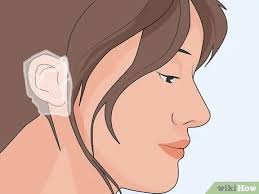10 tips to clean your piercing now
1. Wash Your Hands Before Touching Your Piercing

The first and most important rule of piercing care is always to wash your hands thoroughly before touching your piercing. Your hands carry bacteria and oils that can easily infect a new piercing. Use a gentle, fragrance-free soap and wash for at least 20 seconds. This simple precaution can prevent most common piercing infections.
2. Use Saline Solution for Cleaning

One of the gentlest and most effective ways to clean your piercing is by using a saline solution. You can either buy a pre-made saline solution from a pharmacy or make your own by mixing 1/4 teaspoon of sea salt in 1 cup of warm, distilled water. Apply the saline solution with a clean cotton ball or gauze pad to gently clean the area around the piercing.
3. Avoid Using Harsh Chemicals or Alcohol

While it may be tempting to use alcohol, hydrogen peroxide, or antiseptic solutions to clean your piercing, these can be too harsh. They dry out the skin, slow the healing process, and may even cause scarring. Stick to saline solution or other products recommended by your piercer to avoid irritating the piercing.
4. Clean Twice a Day, Not More

Over-cleaning a piercing can be just as harmful as not cleaning it at all. Cleaning your piercing twice a day is enough—once in the morning and once before bed. Too much cleaning can disrupt the natural healing process, drying out the skin and causing irritation. Follow your piercing professional’s advice on how frequently to clean your particular piercing.
5. Use a Cotton Swab or Gauze, Not Cotton Balls

When cleaning around your piercing, opt for a cotton swab or a piece of gauze rather than a cotton ball. Cotton balls tend to leave behind fibers that can get stuck in the piercing, leading to irritation or infection. A cotton swab can help you get into the crevices of the piercing and clean it without leaving any residue behind.
6. Let the Piercing Air Dry

After cleaning your piercing, avoid wiping it dry with towels or tissues, which can carry bacteria. Instead, allow the piercing to air dry naturally. You can gently pat the area with a clean paper towel if necessary, but don’t rub or use anything abrasive on the piercing.
7. Avoid Removing the Jewelry During Healing

One of the worst mistakes you can make while cleaning a fresh piercing is removing the jewelry before the piercing has fully healed. The hole may close up quickly, trapping bacteria inside, leading to infection. Keep your jewelry in place during the healing process unless a professional piercer advises you to remove it.
8. Shower Instead of Soaking

When cleaning a piercing, you may want to avoid submerging it in water, especially during the initial healing phase. Swimming pools, hot tubs, and even bathtubs can harbor bacteria that can infect your piercing. It’s best to take showers instead of baths and clean the area under running water to avoid unnecessary risk.
9. Avoid Touching Your Piercing With Dirty Hands

Even if you just cleaned your piercing, touching it with dirty hands can introduce bacteria and cause an infection. Make sure that you only touch your piercing after washing your hands thoroughly. Also, avoid playing with the jewelry, as this can irritate the skin and prolong the healing time.
10. Watch for Signs of Infection and Seek Professional Help If Needed

While cleaning is crucial, it’s equally important to pay attention to any signs of infection. Redness, swelling, excessive pain, or unusual discharge (especially if it’s green or yellow) can indicate an infection. If you notice any of these symptoms, contact a professional piercer or healthcare provider immediately for advice.
Conclusion: Patience Is Key
The best trick to ensure your piercing heals properly is patience. Piercings can take anywhere from a few weeks to several months to fully heal, depending on the location and type of piercing. By cleaning your piercing properly, avoiding harsh chemicals, and taking the time to care for it, you can reduce the risk of complications and enjoy your new piercing for years to come!
Bonus Tip: Stay Consistent
Healing takes time, and consistency in care is essential. Set reminders to clean your piercing twice a day and follow all aftercare instructions provided by your piercer. With proper care and attention, you’ll be able to enjoy a healthy, beautifully healed piercing.
By following these 10 simple but essential tricks, you can ensure that your piercing heals safely, and avoid common mistakes that can cause infection or delays in the healing process. Good luck and enjoy your piercing!

A stye (or sty) is a painful red bump on the edge of your eyelid. It can look similar to an acne pimple and may be tender to the touch. A stye forms when a tiny oil-producing gland in your eyelash follicle or eyelid skin becomes blocked and a bacterial infection develops. The medical term for a stye is “hordeolum.”
It’s common to have a stye on only one eyelid, but it’s also possible to get styes on both lids. A stye usually lasts one to two weeks and will typically go away on its own. But in cases where it doesn’t, you may need to rely on an eye care provider to drain it. They may also prescribe antibiotics to reduce the infection.
A stye is similar to another eyelid bump called a chalazion. A chalazion is a bump that usually occurs farther back on your eyelid. Unlike a stye, a chalazion usually isn’t painful and isn’t caused by a bacterial infection. But treatment for both conditions is similar.
Types of styes
There are two types of styes:
- External styes: External styes form on the outer part of either your upper or lower eyelid. They’re the more common type. An infection in your eyelash follicle usually causes them.
- Internal styes: Internal styes form on either of your inner eyelids (facing your eyeball). An infection in the inner eyelid gland that produces oils that help keep your eyelid moist causes this type.
How common are styes?
Styes are very common. They’re more common in adults than children because the oil in an adult’s oil glands is thicker than a child’s. That means it’s more prone to blockage.
Symptoms and Causes
https://imasdk.googleapis.com/js/core/bridge3.688.0_en.html#fid=goog_2057699247Is That Bump on Your Eye a Stye or a Chalazion?
What are the symptoms of a stye?
The main symptom of a stye is a painful red bump along your eyelid edge near your eyelashes. Other stye symptoms may include:
- Swelling of your eyelid (sometimes your entire eyelid).
- Discharge from your eye.
- Crusting along your eyelid.
- Light sensitivity.
- Soreness and itching.
- Eye tearing.
- A scratchy feeling or a feeling that there’s something in your eye.
What causes a stye?
A bacterial infection in your eyelid’s oil-producing glands causes most styes. The oil-producing glands line the eyelids and help lubricate the surface of your eye.
Are styes contagious?
Styes generally aren’t contagious. But small amounts of bacteria can be spread from them. This is why it’s important to always wash your hands before and after touching a stye and wash pillowcases often to help prevent the bacteria from spreading. Unless you’re cleaning or applying warm compresses to the stye, avoid touching it to reduce bacteria spread and irritation.
What are the risk factors for developing a stye?
Styes are very common, and anyone can get them. But you may be more likely to get a stye if you:
- Have had a stye before.
- Have blepharitis (an inflammation of your eyelids).
- Have certain skin conditions, like acne, rosacea or dandruff (seborrheic dermatitis).
- Have diabetes.
- Have dry skin.
- Are experiencing hormonal changes.
- Have high lipid levels (“bad” cholesterol).
Diagnosis and Tests
How is a stye diagnosed?
Some styes are more stubborn and require a visit to a healthcare provider. If your vision seems to be affected or if your stye seems to be getting worse instead of better, contact a provider.
During your appointment, your provider will examine your eyelid and ask about any additional symptoms you’re having. They’ll be able to diagnose a stye based on this eye exam.
Management and Treatment
How do you get rid of a stye?
A stye will usually go away by itself in one to two weeks. To feel better faster and reduce pain and swelling, you can use a self-care plan to treat your stye at home. Here are some dos and don’ts to manage your stye at home.
Do
- Use warm compresses. Apply a warm washcloth to your eyelid for 10 to 15 minutes at a time, three to five times a day. Rewarm the washcloth by soaking it in warm water, wring and repeat. Many people believe that using green tea bags moistened in warm water as eye compresses will help the stye not only feel better, but also speed healing, due in part to the antibacterial properties of green tea. Some scientists have shown that a natural antioxidant in green tea breaks down the cell wall of the bacteria, killing it. While there’s debate about this among eye experts, it won’t hurt you and should be at least as effective as using a warm washcloth as a compress.
- Clean eyelids. Gently wipe away eye discharge with a mild soapy solution made from half baby shampoo and half water. You can also use eyelid wipes available in most drug stores.
Don’t
- Squeeze or pop a stye.
- Rub or touch your eyelid.
- Wear makeup or contact lenses until the area has healed.
How will an eye care provider treat a stye?
If after 48 hours of stye self-care, your pain and swelling aren’t getting any better, it’s time to call your eye care provider. Stye treatment by a medical provider may include:
- A small cut (incision) to drain your stye in the office (under local anesthesia).
- Prescription antibiotic ointment to apply to your eyelid or antibiotic eye drops. Your provider may prescribe oral antibiotics in cases where the area around your eye is infected or after an incision is made to drain an internal stye.
- A steroid injection into the stye to reduce eyelid swelling.
Prevention
Can styes be prevented?
The best way to prevent a stye is to practice good facial hygiene, including:
- Washing your hands thoroughly and often, especially before touching your face and eyes.
- Washing your hands before and after removing contact lenses. Clean your contacts with disinfectant and lens cleaning solution. Dispose of daily wear or other “limited use” lenses on the schedule that your eye care provider recommends.
- Washing your face to remove dirt and/or makeup before going to bed.
- Throwing away eye makeup every two to three months. Never share eye makeup with anyone else.
Outlook / Prognosis
How serious is a stye?
Styes are usually harmless. They may cause some minor irritation and discomfort, but they typically go away on their own. Stye self-care measures like warm compresses can help speed up the healing process.
Although it will be tempting to cover the stye with makeup, avoid doing this. Putting makeup on a stye can delay the healing process or even cause it to become more plugged up and infected, which, in turn, will make it more painful.
Living With
When should I see my healthcare provider?
You should see your healthcare provider if:
- Your eye is swollen shut.
- Pus or blood is leaking from the bump.
- Pain and/or swelling increases after the first two to three days.
- Blisters have formed on your eyelid.
- Your eyelids feel hot.
- Your vision has changed.
- Styes keep coming back. If this happens, your provider may take a biopsy (a small sample of the stye), under local anesthesia, to rule out other more serious problems.
What questions should I ask my healthcare provider?
If you have a stye, you may want to ask your provider the following questions:
- Do styes usually go away on their own?
- How long will it take a stye to heal?
- What treatment options do you recommend?
- Do I need to miss school or work if I have a stye?
- If I’m in a lot of pain, can I take a pain reliever?
A note from Cleveland Clinic
Ouch! What’s that painful red bump that’s developed on your eye? A common cause is a stye. Though they can be painful, most styes aren’t a cause for concern. Having a stye is usually manageable with good eyelid hygiene, and most cases will go away on their own. If the stye persists and doesn’t seem to be getting any better with at-home treatment, contact an eye care specialist.
Care at Cleveland Clinic
Your eyes let you see the world. That’s why it’s important to take care of them. Cleveland Clinic offers comprehensive ophthalmology services to help you do that.
- The 6 Best Stye Remedies
You can treat an eye stye with home remedies and over-the-counter medications. Styes usually resolve in 7-10 days. See a doctor if your stye gets worse or lasts longer than 2 weeks.
Your eyelids have lots of tiny oil glands, especially around the eyelashes.
Dead skin, dirt, or oil buildup can clog these small holes. Bacteria can then grow inside and cause a sometimes painful, pimple-like stye to develop. This is also known as a hordeolum.
The bacteria Staphylococcus aureus or Staphylococcus epidermidis cause about 90–95%Trusted Source of styes.
“Styes usually go away on their own within 7–10 days,” Dr. Michele Green, a New York-based cosmetic dermatologist, told Healthline.
Here are six ways to speed up the healing process for styes.
1. Use a warm compress
A warm compress is the most effective way to treat a stye. The warmth helps bring the pus to the surface, dissolving it so the stye can drain naturally.
Wet a clean washcloth with warm water. Make sure the water isn’t too hot. Wring the cloth, so it’s damp but not dripping. Then gently place it over your eye for about 10–15 minutes. Don’t squeeze or try to puncture the stye.
To keep the washcloth warm, reheat it every 30 seconds by dipping it in warm water and wringing it. Repeat the compress about four times daily for optimal results.
Instead of using a warm cloth compress, you can use a warm tea bag. Black tea works best because it helps reduce swelling and has antibacterial properties.
Add boiled water to a mug, then drop a tea bag as if you were making tea. Let the tea steep for about one minute. Wait until the tea bag cools enough to place over your eye, then keep it on your eye for about 5–10 minutes. Warm it up every 30 seconds by placing it in warm water and wringing it. Use a separate tea bag for each eye.
“You can use black tea as a compress twice daily to reduce swelling and discomfort associated with a stye,” Green said.
However, the wetness might irritate the skin in some people, so you can also make a dry compress by placing a bit of uncooked rice in a sock and microwaving it for 20 seconds. Make sure to press on the bump to help it drain.
You can do this three to four times each day.
2. Clean your eyelid with mild soap and water
Green advises avoiding harsh, synthetic chemicals when cleaning the eye area. Instead, ingredients should be hypoallergenic and nonirritating, she said.
“The skin around the eyes is much thinner than the rest of your face. Therefore, you need to be careful with products you apply to your eye area,” Green said.
She recommends using OCuSOFT to cleanse eyelids because it’s been shown to be effective against bacteria commonly found on the eyelid. Its formula effectively kills seven strains of bacteria, according to Green.
You can also choose a tear-free baby shampoo and mix it with warm water. Use a cotton swab or clean washcloth to gently wipe off your eyelids. You can do this every day until the stye is gone

